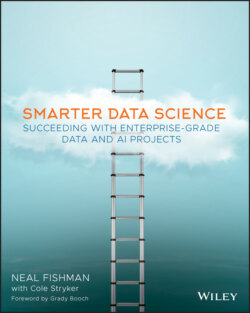Читать книгу Smarter Data Science - Cole Stryker - Страница 16
Readying Data for AI
ОглавлениеThe limitations can be technological, but much of the journey to AI is made up of organizational change. The adoption of AI may require the creation of a new workforce category: the new-collar worker. New-collar jobs can include roles in cybersecurity, cloud computing, digital design, and cognitive business. New-collar work for the cognitive business has been invoked to describe the radically different ways AI-empowered employees will approach their duties. This worker must progress methodically from observing the results of a previous action to justifying a new course of action to suggesting and ultimately prescribing a course of action.
When an organization targets a future state for itself, the future state simply becomes the current state once it's attained. The continual need to define another future state is a cycle that propels the organization forward. Ideally, the organization can, over time, reduce the time and expense required to move from one state to the next, and these costs will be viewed not as expenses but as derived value, and money will cease to inhibit the cycle's progression.
Worldwide, most organizations now agree that AI will help them stay competitive, but many organizations can often still struggle with less advanced forms of analytics. For organizations that experience failure or less than optimal outcomes with AI, the natural recourse seems to be to remove rigor and not increase it. From the perspective of the AI Ladder, rungs are hurried or simply skipped altogether. When an organization begins to recognize and acknowledge this paradigm, they must revisit the fundamentals of analytics in order to prepare themselves for their desired future state and the ability to benefit from AI. They don't necessarily need to start from scratch, but they need to evaluate their capabilities to determine from which rung they can begin. Many of the technological pieces they need may already be in place.
Organizations will struggle to realize value from AI without first making data simple, accessible, and available across the enterprise, but this democratization of data must be tempered by methods to ensure security and privacy because, within the organization, not all data can be considered equal.
